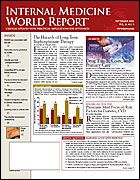Publication
Article
Internal Medicine World Report
Better Hospital–community Coordination Needed to Manage Disasters
Author(s):
More effective communication among hospitals, public health agencies, and community first responders will be needed to effectively manage any future large-scale disasters, according to a new report issued by the Joint Commission on Accreditation of Healthcare Organizations (JCAHO) (Ann Intern Med. 2006; 144: 799-811). The report also notes that national benchmarks are needed to evaluate and promote emergency preparedness funding.
The study, “Integrating Hospitals into Community Emergency Preparedness Planning,” is the first large-scale national assessment of how closely hospitals and their communities are collaborating and planning for natural and other disasters.
“This study provides important new information about the current state of linkages between hospitals and their communities and makes clear that neither can afford to work independently in the face of major emergencies,” said Jerod M. Loeb, PhD, executive vice president, Division of Research at JCAHO. “A coordinated approach is the only way to adequately serve those individuals who are victims of disaster.”
In early 2004, 575 US hospitals responded to a questionnaire that covered 17 basic elements of effective community linkages in a weighted analysis. Respondents included personnel in the areas of environmental safety, emergency management, infection control, administration, emergency services, and security.
Results showed that the majority of hospitals (88.2%) had participated in community-wide drills and exercises, and most (82.2%) had carried out a collaborative threat and vulnerability analysis with community responders (ie, fire, police, and emergency medical services). A total of 57.3% of the hospitals reported that their community plans included information pertaining to their hospitals’ need for additional supplies and equipment, and 73% of the hospitals had addressed decontamination capacity needs. However, only 54.4% of the hospitals reported having a direct link to the Health Alert Network, while 40% had 24-hour access to a live voice from a public health department.
Higher performance scores were associated with large and urban hospitals, and with a perceived high number of hazards, preparation for previous national security events, and experience in actual response.
In response to the study, JCAHO recommends that hospitals participate in drills and exercises that more accurately simulate the stresses created by emergency conditions that can persist over time. The organization also calls upon healthcare organizations to work together to better determine if community resources can meet identified potential needs.
“A well-prepared community will have a comprehensive planning process, a thorough emergency operations plan, established response capability, and an ongoing surveillance and notification system for identifying and communicating emergencies,” lead author Barbara I. Braun, PhD, of the Institute of Crisis, Disaster and Risk Management, George Washington University, Washington, DC, and her coauthors write.






